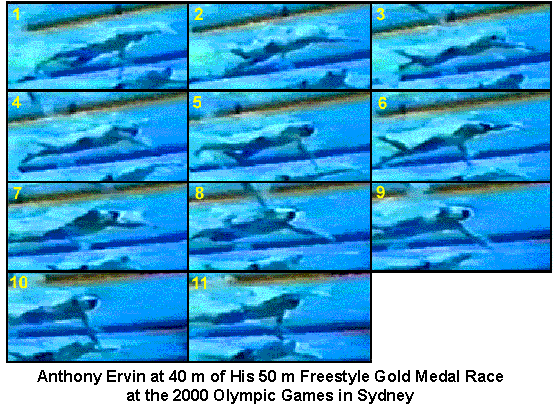HOW CHAMPIONS DO IT
Researched, produced, and prepared by Brent S. Rushall,
Ph.D., R.Psy.

ANTHONY ERVIN AT 40 m OF HIS 50 m FREESTYLE GOLD MEDAL RACE AT THE 2000 OLYMPIC GAMES IN SYDNEY
Each frame is .1 second apart. The quality of the original video sequence of this swim was poor leading to the less than desirable quality of the pictures in this analysis. In this race, Anthony Ervin tied with Gary Hall Jr. in a time of 21.98 seconds.
A 50-m race is not an event on which to conclude ideal movement patterns are displayed and are worthy of emulation. In such a short race, energy conservation and therefore, movement efficiency, is not a primary concern. It is an event in which athletes should attempt to expend as much energy as possible. That requirement causes actions to be exaggerated, leading to a reduction in movement economy.
When compared to other analyses on this site, Anthony Ervin swims with "longer" arms than the other champions featured in events of 100-m or more. In the same race, Gary Hall Jr. also displayed this "lengthened lever" adaptation. In contrast, in the women's 50-m races that have been analyzed, this "lengthening" phenomenon is hardly noticeable. This obvious feature of this swimmer is not something to be copied. One has to ask, "How much faster would Anthony Ervin have swum if he had produced more direct forces earlier in his pull?"
Notable Features
Frame #1 to #3: The right arm entry is followed by a reaching forward and down. In frame #3 the left arm has completed its propulsion without the right arm commencing its propulsion. This produces a lag in beneficial force production and would cause the swimmer's velocity to decline. The swimmer is relatively well streamlined.
Frame #4: The right arm begins to bend at the elbow. However, the drag forces created here are vertical as can be seen by the "milky water" on top of the arm (it indicates the shape of the drag resistance pocket). The upper arm has begun to abduct.
Frame #5: The right arm pull is powered by the internal and external rotator muscles causing abduction of the upper arm in the early pull. At this stage, abduction is turning into adduction even though the same muscle groups are used. The upper arm is aligned with the points of the shoulders enabling a particularly powerful use of the musculature. The propelling surface is the upper arm, lower arm, and hand. The propelling surface is aligned almost vertically to the direction of progression. Although it is difficult to discern, the light blue area in front of the arm indicates the drag pocket, which is centered on the upper portion of the lower arm. The swimmer's head is well down and facilitates streamline.
Frame #6: The right arm continues with adduction. The propelling surface diminishes to being the forearm and hand surfaces. The right shoulder rotates upward. The left arm enters requiring the left shoulder to rotate downward.
Frame #7: Right arm extension is near completion and the "round-out" exit commences. At this stage, right arm propulsion is completed. The left arm has entered. It presses down and forward.
Frame #8: The left arm continues to press down. The trailing drag turbulence off the arm shows that drag forces created here are up and backward. The upper arm abducts producing some leverage that could serve to maintain forward velocity.
Frame #9: The left arm begins to bend at the elbow as the upper arm adducts. Forces at this stage are mostly in an advantageous direction. The narrow drag pocket on the front of the arm indicates the direction of movement that will be produced.
Frame #10: The left arm is relatively "long". The left shoulder has rotated down to produce a very powerful pulling position. The amount of shoulder roll on both sides is a good feature of Anthony Ervin's stroke. The propelling surface at this stage is almost the entire left arm, a position that was also achieved with the right-arm.
Frame #11: The left arm is well into effective adduction with the propulsive surface of the lower arm and hand still being aligned at right angles to the direction of progression.
Anthony Ervin's stroke is not a classic crawl stroke. However, given the unique demands of a 50-m sprint, there are some features worthy of note. His rate is high, achieving a complete arm cycle in slightly more than 1.1 seconds. The use of his shoulders is admirable, being positioned at the time in the stroke when maximum force in the most appropriate direction is desirable. The whole arm producing drag forces in the middle of the stroke shows the importance of concentrating on presenting propelling surfaces in the best manner possible to produce drag forces. The head is well covered and oriented toward the bottom of the pool.
On the negative side, one is set to wonder what might be achieved if the forearm and hand were positioned early in the stroke so that forward propulsion would be achieved earlier in each arm stroke. Such an action is indicated by Alexandre Popov and Inge de Bruijn in their 50-m races.

Return to Table of Contents for this section.




